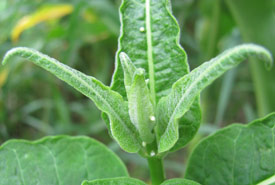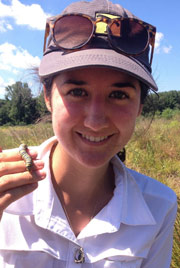Monarch butterfly habitat selection

Monarch butterfly (Photo by A. Dabydeen)
The monarch butterfly is one of the most recognized and loved insects in the world. It is known, in part, for its phenomenal migration from its Canadian breeding grounds to overwintering sites in the mountains of Mexico.
Unfortunately, the reality is that that the eastern North American monarch population has declined by 95 per cent in the last 20 years. The most important factor driving recent declines is the loss of milkweed in the U.S. and Canada.
Female monarch butterflies lay their eggs only on milkweed plants. These offer both food and protection to growing caterpillars. But very little is known about where the best places are to restore milkweed. To fill this knowledge gap, I am studying how monarchs select their habitat during the breeding season, as part of my graduate studies in ecology at the University of Guelph. This information can help inform a more effective milkweed planting strategy.
In some landscapes, female monarchs may be choosing to lay eggs in particular patches of milkweeds over others. They may prefer certain features of a milkweed patch, such as patch size and density. Or, they could be choosing certain areas to avoid predators, parasites or parasitoids (while parasites usually just weaken their hosts, killing the host is necessary to a parasitoid’s life cycle) that could target their offspring.
Monarch eggs are prey for an array of predators such as ants, spiders and true bugs. Not only are they viewed as a tasty meal, but to parasitic wasps and some flies, the caterpillars can also be an attractive host for developing their own larvae. In addition, monarchs are susceptible to a parasite called Ophryocystis elektroscirrha. If they are affected by this parasite, infected monarchs can have trouble emerging as an adult from the chrysalis. Heavily infected individuals may have weakened flight muscles.

Common milkweed. Look closely: do you see four monarch eggs on the leaves? (Photo by Grace Pitman)
In Ontario, Long Point is on a major migratory pathway for monarchs. To see where females are laying eggs in southern Norfolk Country, I am monitoring milkweed patches in three landscapes: agricultural land, roadsides and naturalized meadows. The meadows are all Nature Conservancy of Canada properties containing milkweed and a variety of wildflowers.
It is not only important to know where females are laying eggs. We also need to understand how these choices affect the survival of the next generation of butterflies. To measure survival, I am monitoring the same milkweed patches each week to count the number of caterpillars in each of their five growth stages (called instars). I am also monitoring the presence of predators and parasites at each of the sites.
Monarchs are not only beautiful to observe but they also play a number of functional roles in natural ecosystems during their lifecycle. Butterflies, while not as efficient as bees, are pollinators. Adult monarchs feed on the nectar of a wide variety of wildflowers, therefore playing an important role in the pollination of many plant species.
Monarch butterflies are a potent symbol for the awareness of pollinator declines, which makes them a good species on which to focus research efforts. My work will contribute to our knowledge of optimal milkweed planting strategies to conserve habitat for this iconic species and its amazing migration for generations to come.


